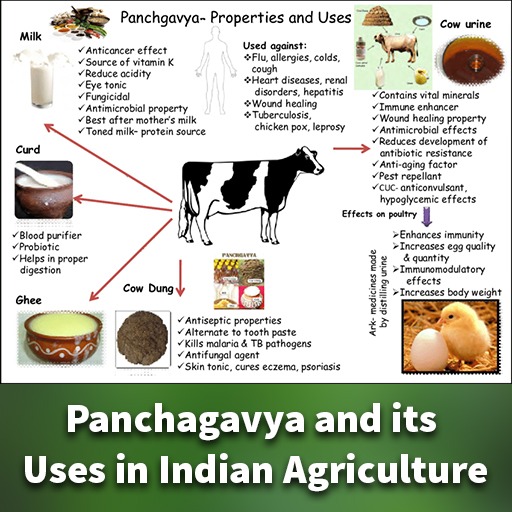India is a country with traditions as old as ancient science that directly connects the social rituals and scientific validations behind them. Cow is venerable in India and is called ‘Gaumata’ or “Kamadheno” because of its mother-like traits. Kamadheno is the name of a holy cow that is famous for believing in the fulfillment of the desired objects.
Panchagavya is a treasure trove of health benefits and therapeutic properties. The Ayurvedic medicinal system highlights the importance of utilizing cow’s milk, ghee, urine, dung, and yogurt. Each of these products is called ‘Gavya’, and is used in the treatment of numerous diseases. They have their unique properties which are beneficial for human health, agriculture, and other purposes.

Avoid Toxic Chemicals:
Panchagavya is a potential source to avoid chemical toxins and it can be easily used in gardens, agriculture, plants, at homes and literally everywhere. Toxic chemicals are extremely hazardous for human health. They cause diseases like hypertension or cancer, skin allergies, inhibit the performance of the immune system, deteriorating human metabolism, etc. They are a threat to our environment as well. These chemicals include pesticides, herbicides and growth promoting chemicals. Once they enter the food chain, they don’t decompose, rather they transfer from one trophic level to another. They get concentrated more and more at each level; a process called biomagnification. Human food gets contaminated by these carcinogens which are a major cause of cancer.
Preparation of Panchagavya:
Select a container and mix a measured amount of 5kg of cow dung and 1kg of ghee in it early in the morning and evening and let it blend thoroughly. Let it be there in a container for about 3-4 days for proper fermentation to occur.
Check the container on the 4th or 5th day. Now add 3 liters of cow urine along with 5 liters of water and leave it again for seven to 8 more days. Mix the ingredients of the container by stirring constantly for 25-30 minutes. Make sure you stir thoroughly twice a day, morning and evening. This stirring will help accelerate aerobic microbial activity. Again, leave this mixture undisturbed for about 15 more days.
After 15 days, add the rest of the ingredients like cow milk, cow yogurt, coconut water, sugarcane juice, banana and jaggery. Again, stir this mixture thoroughly, twice a day i.e. in the morning and evening. Continue this process for about 30 days. After this period, you can use Panchagavya products as you like.
Uses of Panchagavya in Agriculture:
Panchagavya is a product of fermentation and is used in combination with compost, vermicompost, biopesticides, and organic fertilizers. Each of the Panchagavya ingredients has peculiar properties and uses in agriculture and medical fields. Here is a brief overview of Panchagavya uses in agriculture:
Effect on soil
Panchagavya is beneficial for good soil health. It increases the organic matter content in soil, nutrient profile, microbes’ population, and nutrient uptake of plants. It is also capable of increasing physical characteristics of soil like increasing porosity, maintaining water balance, controlling pH of the soil, and balancing the soil’s stability. Use of Panchagavya in agriculture exponentially promotes the growth of healthy microbes around the roots of the plants, thereby, increasing the crop yield.
Effect on Various parts of Crops:
Panchagavya can be used as a foliar spray on plant leaves. This spray results in bigger plant leaves, which means bigger canopy; which enhances photosynthesis in return. This produces maximum photosynthetic products. It also helps develop extra sturdy shoots which means greater fruit yield. With greater water and nutrient intake, plants and crops remain fresh for a longer period of time.
Organic Farming:
Panchagavya is an organic growth promoter and it plays a vital role in developing immunity in plants. It has following ingredient in it:
- Cow dung
- Cow urine
- Cow milk
- Cow curd
- Tender coconut water
- Ghee
- Jaggery
- Banana
- And water
These ingredients have miraculous results when mixed in proper measured quantities. It is the most favorable organic manure for agricultural needs. It has zero harmful synthetic fertilizers, herbicides, insecticides, pesticides etc. Panchagavya is extremely cost effective as compared to other organic manures. It acts as an organic fertilizer by improving soil fertility, worm production, and enhances crop yields. In addition to these, cow dung and urine are great sources of producing biogas and electricity.
Benefits of Panchagavya in Agriculture:
Panchagavya has following benefits in agriculture:
- Panchagavya spray produces bigger leaves and a thick canopy. Bigger leaves mean higher photosynthetic activity and greater metabolites.
- Development of side shoots that are sturdy and they carry a greater number of fruits to maturity.
- Root system is deep and dense. Deep roots ensure greater intake of water and nutrients. Crops and plants stay fresh for a longer time period.
- It helps restore the yield level of crops when they are shifted from inorganic cultivation system to organic culture.
- Harvest time is increased for 15 days which enhances the taste and shelf-life of vegetables and other crops. It promotes greater crop yields and economically strengthens the farmer.
Conclusion:
To wrap up the discussion, we can say that the ingredients of Panchagavya bring quick changes in plants and increase their growth, immunity, and crop productivity. The increase in immunity helps the plant to develop resistance against various diseases and insects or pests. The microbes in the Panchagavya produce metabolites e.g., hydrogen peroxide, organic acids etc. Help the plants to develop resistance against pathogenic bacteria. Thus, Panchagavya has a crucial role in organic farming and sustainable agricultural practices.

